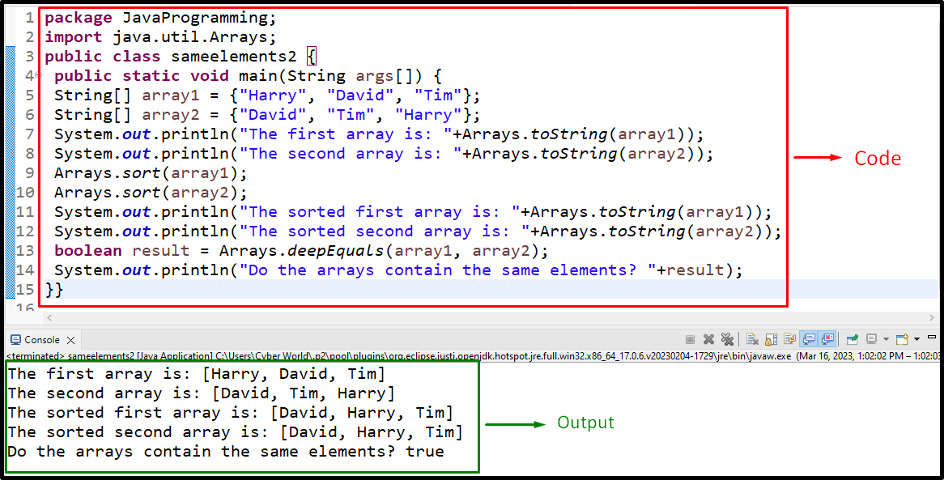This article will elaborate on the approaches to check if two arrays accumulate identical elements in Java.
How to Check if Two Arrays Contain the Same Elements in Java?
To check if two arrays accumulate the same elements in Java, apply the following approaches combined with the “Arrays.sort()” and “Arrays.toString()” methods:
Before proceeding to the approaches, make sure to include the following package to work with “Arrays”:
Approach 1: Check if Two Arrays Contain the Same Elements in Java Using the “Array.equals()” Method
The “Arrays.sort()” method can be used to sort an array completely or a part of it by specifying the start and end indexes and the “Arrays.equals()” method checks if the two arrays are equal or not. The “Arrays.toString()” method in Java, however, returns the provided value in the “string” format.
These approaches can be applied in combination to sort the array elements first, transform them into string representation, and then check for identical elements in both arrays.
Syntax
In the above syntax:
- “array” refers to the array that needs to be sorted.
- “start” is the start index from where to initiate the sorting.
- “end” corresponds to the index where the sorting needs to end.
public static boolean equals(int[] a, int[] a2)
Here, “a” and “a2” point to the arrays that need to be tested for equality.
In this syntax:
- “int[ ] x” indicates the array for which the string representation needs to be returned.
Example
Let’s overview the following example:
public static void main(String args[]) {
int[] array1 = {2, 1, 3};
int[] array2 = {3, 2, 1};
System.out.println("The first array is: "+Arrays.toString(array1));
System.out.println("The second array is: "+Arrays.toString(array2));
Arrays.sort(array1);
Arrays.sort(array2);
System.out.println("The sorted first array is: "+Arrays.toString(array1));
System.out.println("The sorted second array is: "+Arrays.toString(array2));
System.out.println("Do the arrays contain the same elements? "
+Arrays.equals(array1, array2));
}}
In this code, apply the following steps:
- Firstly, declare two arrays of “int” data types having identical elements but in different order and display them.
- After that, apply the “sort()” method twice to sort both the declared arrays.
- Now, apply the “toString()” method to return the sorted arrays in the form of “String”.
- Lastly, check for the contained same elements in both arrays via the “equals()” method.
Output
In this output, it can be observed that the array elements are sorted and checked appropriately.
Approach 2: Check if Two Arrays Contain the Same Elements in Java Using the “Arrays.deepEquals()” Methods
The “Arrays.deepEquals()” method is utilized to check if two single or multi-dimensional arrays are equal or not. However, in this case, this method can be applied to check upon the one-dimensional string arrays.
Syntax
In the above-given syntax, “ob1” and “ob2” correspond to the arrays that need to be checked for equality.
Example
Let’s go through the below-provided example:
public static void main(String args[]) {
String[] array1 = {"Harry", "David", "Tim"};
String[] array2 = {"David", "Tim", "Harry"};
System.out.println("The first array is: "+Arrays.toString(array1));
System.out.println("The second array is: "+Arrays.toString(array2));
Arrays.sort(array1);
Arrays.sort(array2);
System.out.println("The sorted first array is: "+Arrays.toString(array1));
System.out.println("The sorted second array is: "+Arrays.toString(array2));
boolean result = Arrays.deepEquals(array1, array2);
System.out.println("Do the arrays contain the same elements? "+result);
}}
According to this code snippet, perform the following steps:
- First of all, declare two “String” arrays having the stated string values.
- In the next step, likewise, apply the “toString()” method and display the arrays.
- Now, similarly, apply the “sort()” method with each of the defined arrays to sort the array elements.
- Finally, apply the “deepEquals()” method to apply a check upon the identical elements in the arrays, as its argument.
Output
In this outcome, it can be implied that the corresponding outcome against the applied check is returned.
Note: If the check for the identical elements is applied before sorting the array elements, both of the discussed approaches return the “false” outcome.
Conclusion
To check if two arrays accumulate the same elements in Java, apply the “Arrays.sort()” and “Arrays.toString()” methods combined with the “Arrays.equals()”, or the “Arrays.deepEquals()” methods. These approaches can be applied to first, sort the arrays and then return a boolean outcome based on the applied check. This blog demonstrated checking for identical elements in the two arrays.


